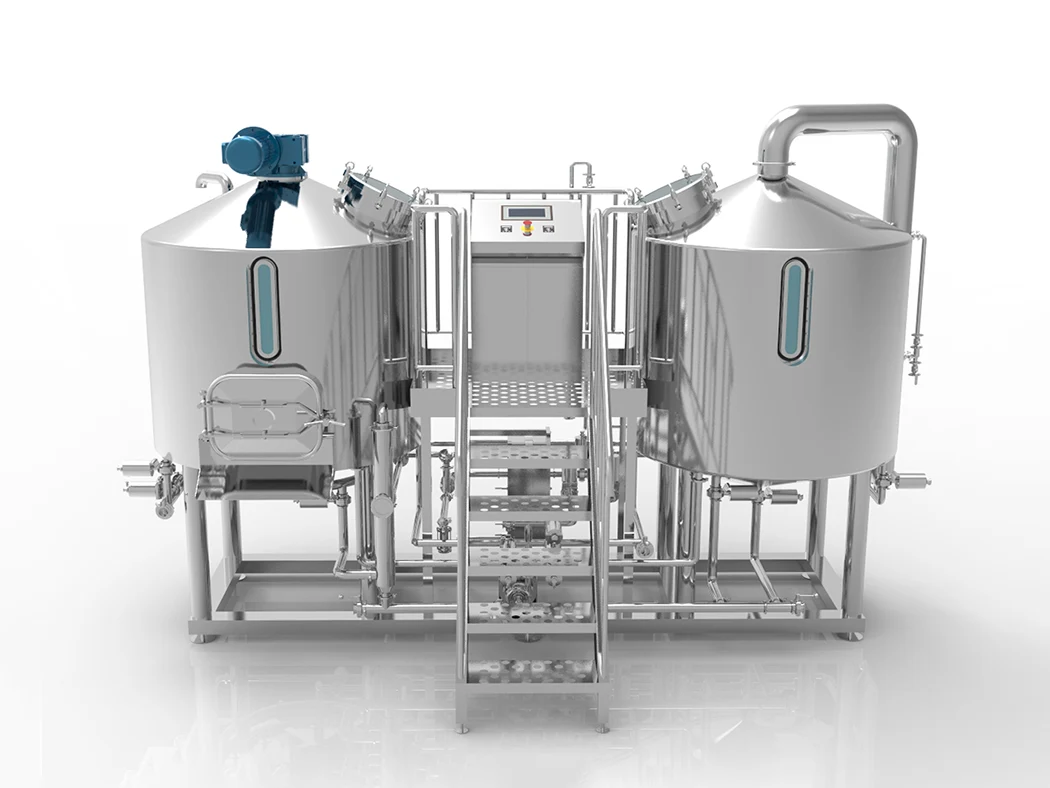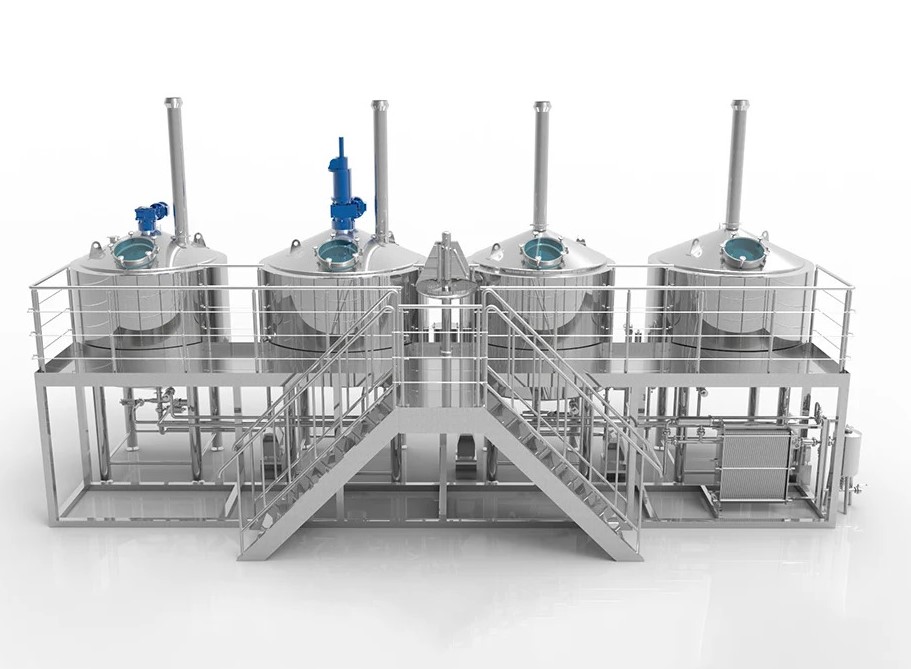Мечтаете открыть собственную пивоварню, но ошеломлены выбором оборудования? Выбор неправильного оборудования приводит к напрасной трате капитала и препятствует производству качественного пива. Как эксперты по производству оборудования для пивоварения, мы поможем вам выбрать идеальное оборудование для коммерческого пивоварения, которое будет способствовать вашему успеху.
Коммерческое оборудование для производства пива относится к специализированному оборудованию и емкостям, используемым пивоваренными заводами для производства пива на продажу. Сюда входит все: от зернодробилок и пивоварен (сусловарочный котел, чайник, вирпул) до бродильных танков, брайт-танков, охладителей, насосов и упаковочных линий. Выбор высококачественного, долговечного и подходящего по размеру коммерческого оборудования для пивоварения имеет решающее значение для эффективного производства, стабильного качества пива и общего успеха ремесленной пивоварни.
Что именно представляет собой коммерческое пивоваренное оборудование?
Когда мы говорим о торговое пивоваренное оборудование, we’re referring to the robust, large-scale systems designed for producing пиво предназначенные для продажи, а не небольшие домашние установки. Это охватывает весь путь пиво От создания сырых ингредиентов до готового продукта, который вы можете предложить своим клиентам. Думайте не только о чайник и ферментерЭто целостная система, созданная для эффективности, последовательности и объема.
В качестве производитель Имея многолетний опыт создания таких систем, мы знаем, что сердце любой пивоварня заключается в его пивоварня. Как правило, для этого используются такие емкости, как заторный тун, лаутерный тун, варочный чайник, и гидромассажная ванна. Наряду с пивоварня, you’ll find essential support оборудование и принадлежностиНапример, резервуары для горячего и холодного раствора, насосы, теплообменники (чиллеры) и сложные контроль температуры systems. It’s the integration and quality of these components that differentiate a hobby setup from professional торговое пивоваренное оборудование.
Сфера применения распространяется на этапы ферментации и кондиционирования, что требует специальных ферментация резервуары (часто конический ферментеры для работы с дрожжами) и брайт-танки для карбонизации и осветления. В заключение, упаковка оборудование - будь то для бочонки, банки или бутылки - завершает коммерческая установка. Каждая деталь играет важную роль в процесс пивоварения, обеспечивая пивовар может надежно производить высококачественный пиво.
Почему высококачественная нержавеющая сталь является промышленным стандартом?
Отблеск нержавеющая сталь isn’t just for show; it’s fundamental to producing excellent пиво. В первую очередь, нержавеющая сталь (особенно нержавеющая сталь 304 или более высоких марок) невероятно устойчива к коррозии и ржавчине. Это очень важно для пивоварня в условиях, когда оборудование постоянно подвергается воздействию влаги, кислого сусла, пивои чистящих средств. Он обеспечивает долговечность и надежность ваших инвестиций.
Кроме того, нержавеющая сталь не пористая и имеет гладкую поверхность. Благодаря этому его очень легко чистить и эффективно дезинфицировать, что имеет первостепенное значение в пивоварении для предотвращения микробного заражения, которое может испортить продукт. партия из пиво. Unlike materials like plastic or wood, it doesn’t harbor bacteria or off-flavors, guaranteeing the purity and intended taste profile of your крафтовое пиво. Из пюре тун к последней порции резервуар, пивоварение из нержавеющей стали оборудование помогает поддерживать высочайшие стандарты гигиены.
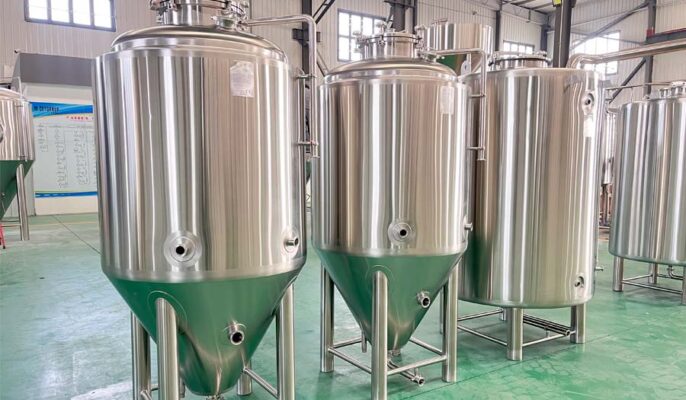
Как производители и установщики, мы используем исключительно высококачественный нержавеющая сталь потому что он также предлагает превосходные контроль температуры свойства. На него можно легко надеть рубашку для нагрева или охлаждения, что позволяет точно регулировать температуру во время затирания и ферментация. Этот контроль необходим для ферментативной активности в пюре и для управления дрожжи здоровье во время ферментация, что напрямую влияет на конечный качественное пиво. Это основной материал для надежных, профессиональных пивоваренное оборудование.
Каковы основные компоненты коммерческой пивоварни?
Сайт пивоварня is where the magic of transforming grain, water, and hops into wort truly happens. It’s the engine room of the пивоварня. Хотя конфигурации могут быть разными (2-, 3-, 4- и т. д.), основные функции остаются неизменными. Основные компоненты обычно включают:
-
Мешанина: В этом сосуде происходит измельчение зерно смешивается с горячей водой (процесс называется затиранием). Цель - активировать ферменты, которые преобразуют крахмал в зерно в ферментируемые сахара. Современные сусловарочные башни часто оснащены функциями для точного контроль температуры и смешивание.
-
Лаутерный туннель: После затирания сладкую жидкость (сусло) необходимо отделить от отработанного зерна. Лаутер тун typically has a false bottom or screen that allows the wort to drain through while holding back the grain husks. Sparging (rinsing the grains with hot water) also occurs here to extract remaining sugars. In some systems, the mash tun and lauter tun are combined into a single “mash/lauter tun”.
-
Заварочный чайник: Собранное сусло переливается в чайник для кипячения. Кипячение стерилизует сусло, изомеризует альфа-кислоты хмеля (создающие горечь), выпаривает лишнюю воду и коагулирует белки (горячий разрыв) для более четкого пиво. Хмель обычно добавляют на разных стадиях варки. Многие пивоварни включают в себя функцию гидромассажа, либо встроенную в чайник или в отдельном сосуде, чтобы помочь отделить остатки хмеля и белковые твердые частицы после кипячения.
-
Поддерживающие элементы: В число необходимых спутников входят надежные насосы предназначенный для работы с горячими жидкостями и твердыми телами, теплообменник (чиллер), чтобы быстро прохладный горячее сусло до температура ферментации до того, как она попадет в ферментер, и трубопроводы/клапаны (фитинги), соединяя все в единое целое.
Understanding these core components is crucial whether you’re looking at a compact system or a larger multi-vessel setup.
Чем отличаются бродильные и брайт-танки?
Хотя оба ферментация танки (ферментеры) и brite резервуары имеют решающее значение для операций после варки, они служат разным целям при создании конечного пиво. Основное различие заключается в их функциях и конструктивных особенностях.
Емкости для брожения это место, где охлажденное сусло встречается с дрожжи. Именно здесь находится основной ферментация происходит: дрожжи потребляют сахар, образовавшийся в пивоварня и производит спирт и CO2. Основные характеристики часто включают:
-
Коническое дно: Облегчает сбор и удаление дрожжевого осадка после ферментация.
-
Куртки для контроля температуры: Решающее значение для поддержания оптимального температура ферментации для конкретного дрожжи деформация, сильно влияющая на beer’s вкусовой профиль. Часто требует подключения к чиллер система.
-
Клапаны сброса давления и порты для проб: Для обеспечения безопасности и контроля закваска.
-
Системы CIP (Clean-In-Place): Для эффективной санитарной обработки.
Аквариумы Brite (также известные как резервуары для кондиционирования или сервировочные резервуары) вступают в игру после первичного ферментация. Их главные роли:
-
Созревание и кондиция: Позволяя пиво для созревания, осветления и слияния ароматов.
-
Карбонизация: Резервуары Brite - это емкости под давлением, специально разработанные для карбонизации пиво до нужного уровня.
-
Уточнение: Возможно дальнейшее оседание остатков дрожжей и твердых частиц.
-
Упаковка: Пиво часто упаковывается непосредственно из британовый бак в бочонки или передается упаковка линия для розлива и консервирования.
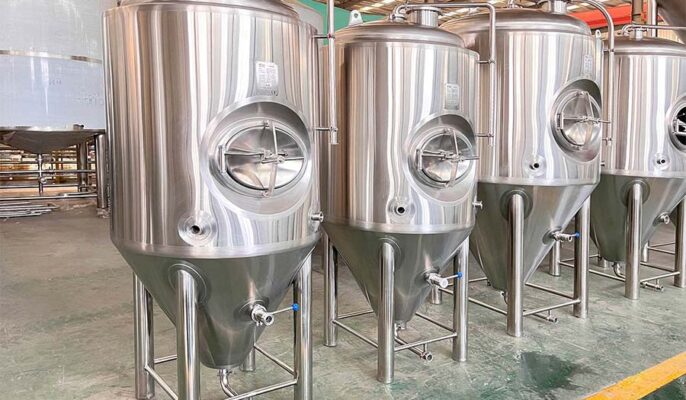
В сущности ферментер предназначена для биологической трансформации, в то время как британовый бак предназначен для отделки, карбонизации и приготовления пиво для сервировки или упаковка. Мы производим широкий ассортимент Емкости для брожения и осветления из нержавеющей стали в соответствии с различными пивоварня масштабы и потребности.
Какое вспомогательное оборудование необходимо для коммерческой пивоварни?
За пределами ядра пивоварня и резервуары для брожения и браги, несколько вспомогательных элементов оборудование и принадлежности жизненно важны для бесперебойной и эффективной работы промышленное пивоварение операции. Пренебрежение ими может привести к возникновению узких мест и снижению качества.
-
Обработка зерна: Все начинается с надежного зерновая мельница. Правильное дробление зерна необходимо для эффективного извлечения сахара во время пюре. Тип мельницы (например, 2-ролик, 4-валковый) зависит от масштаба и желаемой консистенции измельчения. Для транспортировки измельченной массы могут потребоваться шнеки или конвейеры. зерно к сусловарочный тун в больших системах.
-
Чиллеры/гликолевые системы: Быстрое охлаждение сусла после кипячения (через теплообменник) и поддержание точного контроль температуры брожения не подлежат обсуждению. Правильно подобранный гликолевый чиллер Система обеспечивает холодопроизводительность, необходимую как для пивоварня чиллер и куртки на ферментеры и бритые цистерны.
-
Насосы: Пивоваренные заводы нуждаются в различных санитарных насосы предназначены для выполнения различных задач: переливания горячего сусла, перемещения пиво между резервуарами, циркуляции моющих растворов (CIP) и, возможно, для упаковка линии. Выбор правильного насос тип и размер имеют решающее значение для эффективности и целостности продукта.
-
Уборка и санитария: Система очистки на месте (CIP) (чаще всего это переносная тележка с резервуарами, система насоси нагреватель) необходим для эффективной очистки резервуаров и труб. Дополнительно, шайбы для бочек незаменимы для пивоваренных заводов, упаковывающих продукцию в бочонкиПеред повторным заполнением убедитесь, что они тщательно очищены и продезинфицированы.
-
Коммунальные услуги: Надежное горячее водоснабжение (бак для горячей воды), холодное водоснабжение (бак для холодной воды), пар (для парового отопления). пивоварни), сжатый воздух и CO2 - все это является необходимыми элементами.
Инвестиции в надежное вспомогательное оборудование обеспечивают полную процесс пивоварения работает бесперебойно, обеспечивая качество вашего коммерческое пиво.
Как размер пивоварни влияет на выбор оборудования?
Масштаб вашего пивоварня Эксплуатация - это, пожалуй, самый главный фактор, влияющий на ваш торговое пивоваренное оборудование выбор. То, что подходит для небольшого пивного паба, значительно отличается от потребностей регионального производства. пивоварня.
Для стартапов и пивоварен, специализирующихся на выпуске небольших и разнообразных партий, подойдут такие системы, как 300-литровая установка или гибкий Пивоварня на 500 литров предлагают адаптивность и меньшие первоначальные инвестиции. Эти системы часто требуют больших затрат ручного труда, но позволяют проводить эксперименты и осуществлять прямые продажи клиентам. По мере роста производственных потребностей можно перейти к таким системам, как 10BBL 2-х резервуарное оборудование для микропивоваренного производства установка обеспечивает большую емкость при сохранении минимальной занимаемой площади.
Для более крупных производств, нацеленных на широкое распространение, требуются значительно более крупные и часто более автоматизированные системы. Такое оборудование, как система объемом 2000 л или даже значительная 20HL 4 сосуда Оборудование для коммерческой пивоварни становится необходимым. Эти системы предназначены для повышения производительности, эффективности и согласованности больших партий. Они часто включают в себя более сложные системы управления, более ферментеры, больше бритые цистерны, и посвященный упаковка линии. Выбор между 2, 3, 4 или даже 5 сосудами пивоварни зависит от желаемой частоты заваривания, сложности пиво стили и общие производственные цели.
В конечном счете, цель состоит в том, чтобы соответствовать пивоваренное оборудование мощность и уровень автоматизации в соответствии с вашим бизнес-планом и прогнозируемым ростом. Как производители, мы предлагаем масштабируемые решения, обеспечивающие вам пивоварня может развиваться, не испытывая препятствий из-за неадекватного оборудование для пивоварения.
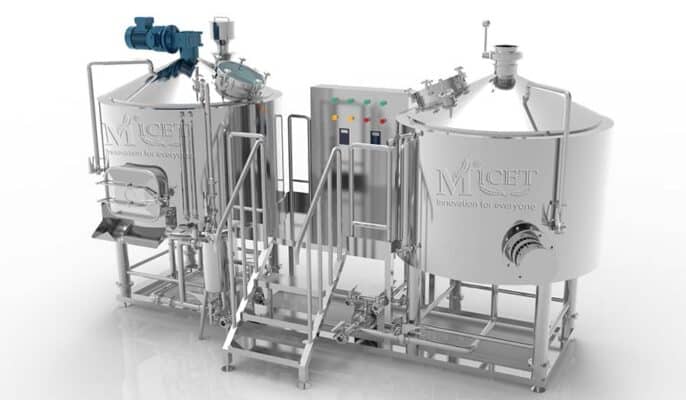
Стоит ли рассматривать автоматизацию при проектировании пивоварни?
Вопрос автоматизации занимает центральное место в современной дизайн пивоварни. Несмотря на существование полностью ручных систем, внедрение определенного уровня автоматизации может значительно повысить эффективность, согласованность и даже безопасность, особенно если речь идет о вашем пивоварня весы.
Базовая автоматизация может включать в себя простые контроль температуры Контуры на резервуарах, автоматически регулирующие расход гликоля для поддержания заданных значений в ферментеры или пюре тун. Это освобождает пивовар от постоянных ручных настроек и приводит к более последовательному ферментация профили и температуры затирания - критические для воспроизводимости качественное пиво. Более продвинутые системы могут автоматизировать последовательность работы клапанов, насос Операции, время добавления хмеля и даже регистрация данных за весь цикл варки.
Реализация автоматизированная система пивоварения предлагает несколько преимуществ:
-
Последовательность: Уменьшает отклонения, вызванные человеческим фактором, гарантируя, что каждый партия конкретного пиво Вкус у рецепта одинаковый.
-
Эффективность: Автоматизация повторяющихся задач позволяет пивоварам сосредоточиться на более важных аспектах, таких как разработка рецептов, контроль качества и управление погребами. Это также позволяет ускорить цикл варки и потенциально снизить затраты на оплату труда.
-
Регистрация данных: Автоматизированные системы часто регистрируют критические данные (температуры, время, объемы), что неоценимо для поиска и устранения неисправностей, оптимизации процесса и контроля качества.
-
Безопасность: Автоматизация таких процессов, как CIP или передача горячего раствора, позволяет сократить ручную работу с потенциально опасными химическими веществами или высокими температурами.
Однако автоматизация предполагает более высокие первоначальные инвестиции и требует наличия персонала с техническими навыками для эксплуатации и обслуживания системы. Оптимальный уровень автоматизации зависит от ваших brewery’s Размер, бюджет, штат и производственные цели. Мы тесно сотрудничаем с клиентами, от тех. новичок в индустрии на опытные пивоварыДля разработки систем с соответствующим уровнем автоматизации.
Какие существуют варианты упаковки коммерческого пива?
Получение готового крафтовое пиво из британовый бак в руки потребителей требует упаковка решение. Основные варианты коммерческие пивоварни Это кегирование, консервирование и розлив.
-
Кегирование: Это часто является отправной точкой для пивоваренных пабов и пивоваренных заводов, ориентированных на продажу разливного пива. Для этого требуется бочонки (имеются различные размеры), бочонок стиральная машина/очиститель, и бочонок Наполнитель. Разлив в кеги относительно прост и сохраняет пиво Качество хорошее, особенно для местного распространения.
-
Консервирование: Cans have surged in popularity due to their portability, complete light protection (preventing “skunky” flavors), and perceived environmental benefits. Canning lines range from small, manual systems suitable for microbreweries to high-speed rotary fillers for large production volumes. Canning requires careful attention to dissolved oxygen levels to maintain пиво стабильность.
-
Бутилирование: Традиционный выбор, линии розлива также сильно различаются по размеру и автоматизации. Бутылки представляют собой классический вид, но они тяжелее, бьются и подвержены воздействию света, если не используется темное стекло. Как и при консервировании, минимизация захвата кислорода при розливе имеет решающее значение для срока хранения.
Выбор зависит от целевого рынка (разливное или розничное пиво), диапазона распространения, имиджа бренда и бюджета. Многие пивоварни используют комбинацию, возможно, разливая в кеги для местных баров и консервируя/разливая в бутылки для розничной продажи. Инвестиции в надежные Упаковочное оборудование имеет решающее значение для представления вашего пиво профессионально и гарантирует, что она дойдет до клиента в оптимальном состоянии.
Насколько важно найти правильного производителя или поставщика оборудования?
Выбор правильного производитель или поставщик для вашего торговое пивоваренное оборудование так же важна, как и выбор правильных ингредиентов для вашего пиво. Это партнерство выходит далеко за рамки первоначальной покупки; оно влияет на дизайн этап, установка, ввод в эксплуатацию и долгосрочная поддержка вашего пивоварня.
Авторитетный поставщиккак и мы, ведет себя скорее как консультант и партнером. Мы привносим многолетний опыт в изготовление и установка пивоваренные системы всех размеров. Это означает, что мы можем предоставить бесценные знания во время дизайн пивоварни На этапе проектирования мы поможем вам оптимизировать планировку, рабочий процесс и требования к инженерным коммуникациям. Мы понимаем все нюансы нержавеющая сталь производство, стандарты сварки и санитарные нормы дизайн решающий для качественное оборудование для пивоварения.
Ищите производители и монтажники которые предлагают:
-
Персонализация: Возможность адаптации пивоваренное оборудование в соответствии с вашим пространством, бюджетом и стилем пивоварения.
-
Качество материалов и изготовления: Использование высококачественный нержавеющая сталь 304 или лучше, соблюдение санитарных норм при сварке, а также общая надежность.
-
Комплексная поддержка: Помощь в установке, вводе в эксплуатацию, обучение, а также доступная техническая поддержка и запасные части после установки.
-
Проверенный опыт: Опыт работы и положительные рекомендации в компании пивоваренная промышленность. Могут ли они продемонстрировать успешные установки, аналогичные вашему проекту?
-
Понимание своего видения: A partner who listens to your goals, whether you’re a startup aiming to оживить ремесленное пиво или установленный пивоварня расширение возможностей.
Выбор самого дешевого варианта может привести к дорогостоящим простоям, несовместимым пиво качество и разочарование в дальнейшем. Сотрудничество с опытным производитель как Micet Group, гарантирует, что вы инвестируете в надежность, высочайшее качество оборудование и принадлежности built for long-term success. Don’t underestimate the value of expertise and ongoing support when making such a significant investment.
Не только пиво: можно ли использовать это оборудование для других напитков?
Безусловно! Несмотря на то, что он разработан с варка пива В виду, что основные принципы и большая часть нержавеющая сталь оборудование, используемое в пивоварня Они легко адаптируются для производства других ферментированных напитков. Такая универсальность является значительным преимуществом для предпринимателей, стремящихся разнообразить ассортимент своей продукции.
-
Комбуча: Сайт бродильные ёмкости используемый для пиво идеально подходят для приготовления комбучи. С точным контроль температуры capabilities, you can manage the SCOBY’s activity effectively. We even offer specialized Емкость для брожения комбучи дизайны, разработанные специально для этой популярной напитки.
-
Вино и сидр: Ферментеры из нержавеющей стали и бритые цистерны являются основными на современных винодельнях и сидровых заводах для чистого, контролируемого брожения и кондиционирования. Несмотря на то, что вначале может потребоваться некоторое специализированное оборудование, например прессы, основная инфраструктура резервуаров очень похожа.
-
Крепкий зельтцер: Процесс производства часто включает в себя ферментацию сахарной основы, которая может быть выполнена в стандартных ферментерыЗатем следует фильтрация и ароматизация, часто с использованием бритые цистерны.
-
Дистилляция: В то время как для дистилляции требуется особый штиль, на начальных этапах создания промывки (ферментация зерна или сахара) используется оборудование, очень похожее на пивоварня и ферментеры.
-
Другие напитки: Оборудование, такое как смесительные баки и общее нержавеющая сталь Суда находят применение во всех сферах напитки Промышленность для смешивания ингредиентов, хранения и обработки.
Основные инвестиции в высококачественные, санитарные нержавеющая сталь резервуары и контроль температуры Система обеспечивает гибкую основу для производства широкого спектра напитков, помимо коммерческое пиво. Такая способность к адаптации может стать важным преимуществом для развития вашего бизнеса.
Вопросы и ответы
Каков типичный диапазон цен на оборудование для коммерческого пивоварения?
Стоимость варьируется в широких пределах в зависимости от размера системы (от небольших пилотных систем стоимостью $50 тыс. до крупных производственных пивоварен стоимостью в миллионы), уровня автоматизации, количества емкостей (2 емкости против 5 емкостей). пивоварни), репутация бренда (ведущие бренды против менее известных производители), и неважно, покупаете ли вы новый или рассматриваете подержанное пивоваренное оборудование. Стартовая система объемом 7-10 баррелей часто попадает в
150k-350 тысяч за ядро пивоваренное оборудованиерезервуары и основные вспомогательные системы, не считая расходов на установку и строительство.
Сколько места мне нужно для установки коммерческой пивоварни?
Требования к пространству в значительной степени зависят от пивоварня размер, количество и размер ферментеры и бритые цистерны, упаковка Линейные площади, складские помещения для сырья и готовой продукции, холодильные камеры (в помещении прохладныйи вспомогательные помещения (офис, тап-рум, лаборатория). Даже небольшой нано-пивоварня Для этого может потребоваться 1 000-1 500 кв. футов, а для крупных производств - десятки тысяч квадратных футов. Правильный дизайн пивоварни и планировка имеют решающее значение.
What’s the difference between direct fire, steam, and electric heating for the kettle?
Прямой огонь (чайник нагревается непосредственно горелками, расположенными под ним) распространен в небольших системах, но может привести к риску ожогов и обеспечивает менее точный контроль. Паровое отопление (с использованием паровых рубашек вокруг чайник) обеспечивает равномерный и эффективный нагрев и входит в стандартную комплектацию большинства торговое пивоваренное оборудование но требует наличия парового котла. Электрическое отопление (с использованием погружение Элементы или электрические рубашки) обеспечивают точный контроль и позволяют обойтись без котла, но могут иметь более высокие эксплуатационные расходы энергии и медленное время нагрева при больших объемах.
Do I need a brewing consultant if I’m new to the industry?
Хотя это и не обязательно, особенно если вы работаете с опытным поставщик оборудования который предлагает поддержку в разработке дизайна, пивоварение консультант can be invaluable if you’re новичок в индустрии. Они могут помочь с составлением рецептов, оптимизацией процесса, навигацией по нормативам, контролем качества установкаи общего бизнес-планирования, дополняя техническую экспертизу, предоставляемую разработчики оборудования для пивоварения и производителей.
Сколько времени занимает изготовление и установка оборудования для пивоварни?
Сроки выполнения заказа существенно различаются в зависимости от manufacturer’s от того, насколько сложна и велика система, а также от требований по настройке. Производство обычно занимает от 2 до 6 месяцев. Время установки зависит от готовности площадки, сложности оборудования и опыта специалистов. производители и монтажникиПотенциально это может занять от нескольких недель до нескольких месяцев для крупных проектов.
Какое обслуживание требуется коммерческому пивоваренному оборудованию?
Регулярное техническое обслуживание имеет решающее значение для долговечности и производительности. Оно включает в себя регулярную чистку и санитарную обработку (ежедневно/еженедельно), профилактическое обслуживание насосы и двигателей (замена прокладок, смазка), калибровка приборов (контроль температуры датчики, манометры), контроль сварных швов и фитингии периодическая глубокая очистка или пассивация нержавеющая сталь танки. После manufacturer’s Рекомендуемый график технического обслуживания является ключевым моментом.
Основные выводы для инвестиций в пивоварню
-
Качество имеет значение: Инвестиции в высококачественный, нержавеющая сталь торговое пивоваренное оборудование от авторитетного производитель имеет решающее значение для производства последовательных качественное пивоОбеспечение операционной эффективности и долгосрочной надежность.
-
Системные компоненты: Поймите функцию каждой основной детали: зерновая мельница, пивоварня (пюре тун, чайник, и т.д.), ферментеры, бритые цистерны, чиллер, насосы, и упаковка системы.
-
Подберите подходящий размер: Выберите пивоваренное оборудование мощности на основе вашего текущего бизнес-плана и реалистичных прогнозов роста. Масштабируемость - ключевой момент.
-
Системы поддержки: Don’t overlook essential support equipment like glycol chillers, CIP systems, шайбы для бочеки надлежащее обеспечение коммунальными услугами.
-
Потенциал автоматизации: Рассмотрите преимущества автоматизации для обеспечения последовательности и эффективности, соизмеряя инвестиции с вашими операционными потребностями и масштабом.
-
Партнерство с производителем: Выберите поставщик который выступает в качестве партнера, предлагая опыт проектирования, настройки, поддержки при установке и постоянного обслуживания. Эти отношения жизненно важны для того, чтобы сделать ваш крафтовое пиво в жизнь.
-
Универсальность: Помните, что большая часть основных нержавеющая сталь Оборудование может быть адаптировано для приготовления других напитков, таких как комбуча, сидр или вино, что обеспечивает гибкость в будущем.

